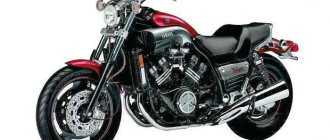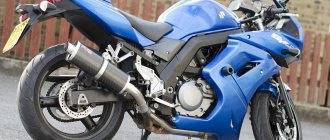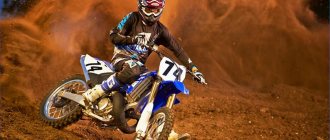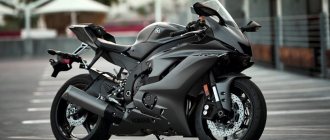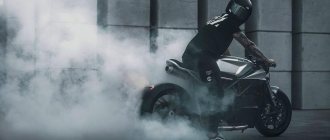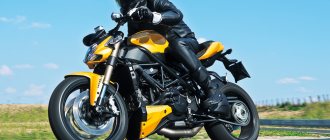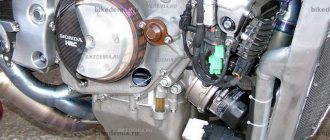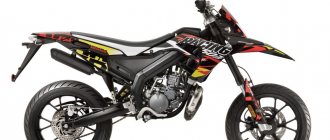Hi all. My name is Sergey, I am from St. Petersburg. I'm new here, but I still decided to share my review and story. I decided to write a little about my first sports motorcycle. Before that I owned a motocross Yamaha YZ-450, but that's a different story. The desire to buy a motorcycle appeared when I was 15-16 years old; by the way, I’m 24 now. So, the desire to buy a bike at that age is very fraught, since the predominance of show-off over reason is of maximum importance. It’s especially sad to watch when parents buy a sports bike for their child, and here he is, without the proper equipment and skills, trying to show that he is the king of the road. At best it ends in a hospital. But having made a small retreat, looking at 80% of St. Petersburg’s bikers, I realized that not only the younger generation, but also the adults, do not care about their safety. I met pilots with full equipment extremely rarely. Still, they think I’m careful. Although the asphalt is equally hard at any speed. As time passed, reason gradually began to emerge, an awareness of responsibility, as well as an understanding that this was a dangerous technique. Hundreds of views of various videos on one well-known video hosting site. And then at one moment I decided that it was time. The search for sports bikes began (By the way, why sports? Answer: They are just beautiful.) After looking at about 100 ads, all over Russia. I realized that the task was not easy. Either they were killed, or the docks were problematic, or the owner was shady. As a result, I found my Yamaha in St. Petersburg with one very caring owner, who drove it from Europe in 13, he owned it for 5 years. A very long time to own a motorcycle. Usually, many are drained at the end of the season. We checked, bargained, the money was in the cash register - a lot of joy. We struggled a bit with registration because of insurance. But the road will be mastered by those walking, so they set it to 5 hours. Thank you for reading up to this point, now there will be less lyrics. I have owned this motorcycle for a month now, and I decided to share information about the motorcycle. Maybe it will be useful to someone So, Yamaha YZF R6 2004, 600 cc. and many horses. The first ride on it was accompanied by a smile and childish joy, and sweat in the palms. The way it drives, the first week it didn’t raise the revs above 6-8 thousand. I got used to it, felt the motto. It steers perfectly, you just need to get used to it. The throttle seemed very sharp at first, but I got used to it after some time. The main thing to remember is that a motorcycle can do much more than your capabilities. I rolled for about 2 weeks, I didn’t check the acceleration to 100 and so on, because in city conditions I don’t want to create emergency situations. I'll get out to the track and check it there. But he picks up very quickly, he was driving 230 along the Priozerskoe highway, but at least he keeps going and going. The motorcycle is quite inexpensive to maintain. Changing oil, filters, spark plugs, front tires, brake fluid with bleeding. 7190 (+5 thousand spare parts) After 8 thousand, the motorcycle begins to accelerate explosively and it starts to ride very, very cheerfully. The seating position is sporty, but probably not very comfortable for daily trips to the city. Maybe due to sports training, even after an hour of driving, my hands don’t become numb, my back doesn’t ache.
My name is Sergey, I am from St. Petersburg. I'm new here, but I still decided to share my review and story. I decided to write a little about my first sports motorcycle. Before that I owned a motocross Yamaha YZ-450, but that's a different story. The desire to buy a motorcycle appeared when I was 15-16 years old; by the way, I’m 24 now. So, the desire to buy a bike at that age is very fraught, since the predominance of show-off over reason is of maximum importance. It’s especially sad to watch when parents buy a sports bike for their child, and here he is, without the proper equipment and skills, trying to show that he is the king of the road. At best it ends in a hospital. But having made a small retreat, looking at 80% of St. Petersburg’s bikers, I realized that not only the younger generation, but also the adults, do not care about their safety. I met pilots with full equipment extremely rarely. Still, they think I’m careful. Although the asphalt is equally hard at any speed. As time passed, reason gradually began to emerge, an awareness of responsibility, as well as an understanding that this was a dangerous technique. Hundreds of views of various videos on one well-known video hosting site. And then at one moment I decided that it was time. The search for sports bikes began (By the way, why sports? Answer: They are just beautiful.) After looking at about 100 ads, all over Russia. I realized that the task was not easy. Either they were killed, or the docks were problematic, or the owner was shady. As a result, I found my Yamaha in St. Petersburg with one very caring owner, who drove it from Europe in 13, he owned it for 5 years. A very long time to own a motorcycle. Usually, many are drained at the end of the season. We checked, bargained, the money was in the cash register - a lot of joy. We struggled a bit with registration because of insurance. But the road will be mastered by those walking, so they set it to 5 hours. Thank you for reading up to this point, now there will be less lyrics. I have owned this motorcycle for a month now, and I decided to share information about the motorcycle. Maybe it will be useful to someone So, Yamaha YZF R6 2004, 600 cc. and many horses. The first ride on it was accompanied by a smile and childish joy, and sweat in the palms. The way it drives, the first week it didn’t raise the revs above 6-8 thousand. I got used to it, felt the motto. It steers perfectly, you just need to get used to it. The throttle seemed very sharp at first, but I got used to it after some time. The main thing to remember is that a motorcycle can do much more than your capabilities. I rolled for about 2 weeks, I didn’t check the acceleration to 100 and so on, because in city conditions I don’t want to create emergency situations. I'll get out to the track and check it there. But he picks up very quickly, he was driving 230 along the Priozerskoe highway, but at least he keeps going and going. The motorcycle is quite inexpensive to maintain. Changing oil, filters, spark plugs, front tires, brake fluid with bleeding. 7190 (+5 thousand spare parts) After 8 thousand, the motorcycle begins to accelerate explosively and it starts to ride very, very cheerfully. The seating position is sporty, but probably not very comfortable for daily trips to the city. Maybe due to sports training, even after an hour of driving, my hands don’t become numb, my back doesn’t ache.
What I didn’t like was the lack of a fuel level, only an indicator that it was time to refuel. On average, before the indicator lights up, it lasts for 150-250 km, depending on how you drive. I can’t describe the suspension, it’s quite stiff, there’s nothing to compare it with. But this is a sportbike, there is no need to demand softness. What I like is the endless supply of power, it will accelerate at any moment, at any speed. This is a very pleasant feeling. The beauty of the bike, no matter what. I like that every time I approach a motorcycle, the child’s smile never leaves my face. Maybe it will pass, though.
After driving around the city for a month, in a 600 in the first season, I realized the main thing. It's not worth driving in the city. Maximum +20 km from the flow speed, analyze and look at the nearest cars, look at the mirrors, and know that no one sees you. There were 2-3 emergency situations, the minibus decided to turn around through 3 lanes, a woman missed a turn and so made a U-turn without turn signals, and at the intersection there was a man flying through the red light. In all cases, I had a safe speed to make a decision. So everything ended well. Would I recommend a new 600cc bike for a newbie? Yes, if you have a head on your shoulders and the awareness that they are waiting for you at home.
Specifications
Yamaha YZF-R1 Specifications:
| Model | Yamaha R1 (YZF-R1) |
| Motorcycle type | sport |
| Year of issue | 1998+ |
| Frame | aluminum Deltabox |
| engine's type | 4-cylinder, 4-stroke, in-line Crossplane (90° cranks) crankshaft – R1 (2009+) |
| Working volume | 998 cm³ |
| Bore/Stroke | 74.0 x 58.0 mm – R1 (1998-2003) 77.0 x 53.6 mm – R1 (2004-2008) 78.0 x 52.2 mm – R1 (2009-2014) 79.0 x 50.9 mm – R1 (2015+) |
| Compression ratio | 11.8:1 – R1 (1998-2003) 12.4:1 – R1 (2004-2006) 12.7:1 – R1 (2007-2014) 13.0:1 – R1 (2015+) |
| Cooling | liquid |
| Number of valves per cylinder | DOHC, 5 valves per cylinder – R1 (1998-2006) DOHC, 4 valves per cylinder – R1 (2007+) |
| Fuel supply system | Carburetor, 4x Mikuni BDSR40 – R1 (1998-2001) Injector, 4x Mikuni 40EIS – R1 (2002-2003) Injector, Mikuni 45EIDW – R1 (2004+) YCC-I (Yamaha Chip Control Intake) – R1 (2007+) YCC-T (Yamaha Chip Control Throttle) – R1 (2007+) |
| Ignition type | TCI |
| Maximum power | 150.0 hp (110.0 kW) at 10,000 rpm – R1 (1998-2001) 152.0 hp (112.0 kW) at 10500 rpm – R1 (2002-2003) 172.0 hp (126.0 kW) at 12500 rpm – R1 (2004-2005) 175.0 hp (129.0 kW) at 12500 rpm – R1 (2006) 180.0 hp (132.0 kW) at 12500 rpm – R1 (2007-2008) 182.0 hp (134.0 kW) at 12500 rpm – R1 (2009-2014) 200.0 hp (147.0 kW) at 13500 rpm – R1 (2015+) |
| Maximum torque | 108.0 Nm (11.0 kg*m) at 8500 rpm – R1 (1998-2001) 105.0 Nm (11.0 kg*m) at 8500 rpm – R1 (2002-2003) 107.0 Nm (11.0 kg*m) at 10500 rpm – R1 (2004-2006) 113.0 Nm (11.5 kg*m) at 10,000 rpm – R1 (2007-2008) 116.0 Nm (12.0 kg*m) at 10,000 rpm – R1 (2009-2014) 112.0 Nm (11.5 kg*m) at 11500 rpm – R1 (2015-2019) 113.3 Nm (11.6 kg*m) at 11500 rpm – R1 (2020+) |
| Clutch | Multi-disc in oil bath, cable drive |
| Transmission | 6-speed |
| type of drive | chain |
| Front tire size | 120/70ZR17 M/C (58W) |
| Rear tire size | 190/50 ZR17 (73W) – R1 (1998-2000) 190/55 ZR17 M/C (75W) – R1 (2009+) 200/55 ZR17 M/C (78W) – R1M |
| Front brakes | 2 discs, 298 mm, 4-piston calipers – R1 (1998-2003) 2 discs, 320 mm, 4-piston radial calipers – R1 (2004-2006) 2 discs, 310 mm, 6-piston radial calipers – R1 (2007-2014) 2 discs, 320 mm, 4-piston radial calipers (combined UBS – Unified Brake System + ABS) – R1 (2015+) |
| Rear brakes | 1 disc, 245 mm, 2-piston caliper – R1 (1998-2001) 1 disc, 220 mm, 2-piston caliper – R1 (2002-2003) 1 disc, 220 mm, 1-piston caliper – R1 (2004+) (2015+: combination UBS – Unified Brake System + ABS) |
| Front suspension | 41mm inverted telescopic fork (fully adjustable), 135mm travel - R1 (1998-2001) 43mm inverted telescopic fork (fully adjustable), 120mm travel - R1 (2002+) Öhlins electronic semi-active suspension – R1M |
| Rear suspension | Pendulum with monoshock absorber (fully adjustable), stroke – 130 mm – R1 (1998-2008) Pendulum with monoshock absorber (fully adjustable), travel – 120 mm – R1 (2009+) Öhlins electronic semi-active suspension – R1M |
| Length | 2035 mm – R1 (1998-2001) 2040 mm – R1 (2002-2003) 2065 mm – R1 (2004-2005) 2085 mm – R1 (2006) 2060 mm – R1 (2007-2008) 2070 mm – R1 (2009-2014) 2055 mm – R1 (2015+) |
| Width | 695 mm – R1 (1998-2001) 705 mm – R1 (2002-2003) 720 mm – R1 (2004-2008) 715 mm – R1 (2009-2014) 690 mm – R1 (2015+) |
| Height | 1095 mm – R1 (1998-1999) 1105 mm – R1 (2000-2006) 1110 mm – R1 (2007-2008) 1130 mm – R1 (2009-2014) 1150 mm – R1 (2015+) |
| Wheelbase | 1395 mm – R1 (1998-2006) 1415 mm – R1 (2007-2014) 1405 mm – R1 (2015+) |
| Minimum ground clearance (clearance) | 140 mm – R1 (1998-2003) 135 mm – R1 (2004-2014) 130 mm – R1 (2015+) |
| Seat height | 815 mm – R1 (1998-2001) 820 mm – R1 (2002-2003) 835 mm – R1 (2004-2014) 855-860 mm – R1 (2015+) |
| Acceleration to 100 km/h | 2.88 sec |
| Maximum speed | 293 km/h |
| Gas tank capacity | 18.0 l (including reserve - 5.5 l) - R1 (1998-1999) 18.0 l (including reserve - 3.8 l) - R1 (2000-2001) 17.0 l (including reserve - 3.3 l) - R1 (2002-2003) 18.0 l (including reserve - 3.4 l) - R1 (2004-2006) 18.0 l (including reserve - 3.2 l) - R1 (2007-2008) 18.0 l (including reserve - 3.1 l) - R1 (2009-2014) 17.0 l (including reserve – 3.0 l) – R1 (2015+) |
| Motorcycle weight (curb) | 198 kg – R1 (1998-1999) 194 kg – R1 (2000-2001, 2006) 193 kg – R1 (2002-2005) 200 kg – R1 (2007-2008, 2015+) 206 kg – R1 (2009-2014) |
Clock in YZF-R6
What deserves a world cup in the “we did it well” category is the watch of this bike. A classic large clickable speedometer with switch does the job. I don't know why this is going away, but this is how speedometers and tachometers on motorcycles should be. Not only because they look beautiful, but also because they are megabit. Nothing breaks like a thin, invisible rotation bar. Well, that's probably another suggestion for using a motorcycle: ideas about mileage, speed, mileage, combustion and hours are standard. Classic genre. Plus controls all the evils and systems extracted from the rev counter of the rev counter. DIAMOND!
A brief history of the motorcycle
The Yamaha R6 was first introduced in 1998. The new model replaces the Yamaha YZF600R Thundercat. In 2001, the engine of the new product was modernized: the engine design became lighter, forged pistons were installed, and the capacity was also reduced. The Yamaha P6 motorcycle underwent its first restyling in 2003. Then the carburetor was replaced with an injector, the appearance of the decorative plastic and the headlight changed. The next changes occurred in 2005, when minor changes were made to the design of the engine systems. In 2006, the design of the plastic, headlights and exhaust system changed again. The engine became more powerful, the volume of the fuel tank increased, an injection system with double injectors was installed, and the ignition system was updated. External changes for 2008 are not as noticeable as the effects of previous redesigns. Then the engine power increased slightly, and the engine displacement decreased again. Later, in 2010, the design was redesigned again and changes were made to the operation of the exhaust system.
Repair and service
Sportbikes in the 600 class are quite popular motorcycles. Manufacturers have managed to polish their models over the years of production, so there are no major flaws in motorcycles. Yamaha, as one of the representatives of the class, is no exception.
However, the very specifics of the motorcycle have nuances. Sometimes those who like to put a motorcycle on the rear wheel, but do not have the necessary experience, manage to disrupt the geometry of the frame with sharp blows when lowering the motorcycle. The rigid suspension of a sportbike is not capable of handling such loads. But, as we understand, these are only operational features.
Replacing consumables does not distinguish a motorcycle from its analogues, and here a sportbike, when ridden aggressively, is capable of destroying everything that we so diligently installed at the beginning of the season at cosmic speed.
The disadvantages of many sport bikes include the absence of a central stand, which greatly simplifies procedures such as replacing tires, chains, oil, and brake pads. Therefore, you will be forced to purchase special tackles.
The birth of a legend. History of the model.
At the time of birth, it was the fastest motorcycle on the planet! Up to a hundred - less than three seconds, and only seven and a half - up to two hundred. However, the bike did not become a “death capsule”, because along with such incredible speed characteristics it received excellent handling, gaining fame as a very “racer-friendly” machine.
The designers managed to achieve this: firstly, by moving the bike’s center of gravity as low as possible, and, secondly, by reducing the wheelbase and increasing maneuverability.
The legendary motorcycle is already 16 years old, and during all this time its recognizable appearance has changed, if at all, not too significantly, which means it was successful from the very beginning.
The 2002 Erka differed insignificantly from the first motorcycle: an improved injection system and easy suspension upgrades. The main difference is a new, cast frame with minimal welding, which makes it more rigid.
Two years later, another model appeared, easily recognizable by its front-mounted air intakes. There were no significant changes in the design - the brakes and steering wheel were slightly modernized, equipped with a damper.
And only in 2007, the model range was replenished with a bike with a modified engine with a 4-valve arrangement per combustion chamber. However, the declared 182 “horses” look cool only on the stands. In practice, on the way to the drive wheel, 36 of them run away somewhere...
2009 was marked by the appearance of a number of improvements on the sportbike, designed not to increase speed, make cornering easier, or save a couple of milliseconds on anything else. No! Erka was equipped with several ignition maps for different weather and type of road surface. It seems that for the first time the designers of a crazy sportbike seriously, like adults, were concerned about the safety of the pilot.
The trend continued and in 2012 the Erka arrived with traction control. And here the designers were original: this bike does not have tilt angle sensors. Their function is performed by sensors located on the wheels.
Description of the Yamaha YZF-R6 sportbike
A detailed analysis of the characteristics of the Yamaha YUZF R6 bike can be studied below.
Design Features
The motorcycle is made in the classic style of Japanese sports bikes. Featuring a fetal-shaped fit for maximum streamlining.
Weight and dimensions
The weight of the Yamaha P6 is 166 kg, its length is 204 cm, width – 70.5, height – 110 cm.
The motorcycle is made in the classic style of Japanese sports bikes
Brief history of the model
Model
: Yamaha YZF750R;
Yamaha YZF750SP (Europe, Japan). Factory designation
: 4FM1, 4FN1, 4HD1, 4HD2, 4HN1, 4HR1, 4HT1; 4JD1, 4HS1, 4HS2.
Model
: Yamaha YZF750R;
Yamaha YZF750SP (Europe, USA). Factory designation
: 4FM2, 4FN2, 4HD3, 4HD4, 4HN2, 4HR2, 4HT2, 4HY2, 4JA2, 4LE1, 4LE2; 4HS3, 4HS4.
Model
: Yamaha YZF750R;
Yamaha YZF750SP (Europe, Japan). Factory designation
: 4FM3, 4HD5, 4HD6, 4HN3, 4HR3, 4HT3, 4HY3; 4JD2, 4HS5, 4HS6.
Model
: Yamaha YZF750R;
Yamaha YZF750SP (Europe, USA). Factory designation
: 4FM4, 4HD7, 4HD8, 4HN4, 4HR4, 4HT4, 4HY4, 4JA4, 4LE3, 4LE4; 4HS7, 4HS8.
Model
: Yamaha YZF750R;
Yamaha YZF750SP (Europe, USA). Factory designation
: 4HY5, 4LE5, 4LE6.
Model
: Yamaha YZF750R (Europe, USA).
Factory designation
: 4HY6, 4LE7, 4LE8.
Specifications
Let's briefly look at the main technical characteristics of the Yamaha R6.
Fuel consumption
The bike consumes from 6 to 8 liters of fuel per 100 km. How many cubes a Yamaha P6 has depends on the year of manufacture. Most models are equipped with a 600 cc engine. cm.
engine's type
The bike is equipped with a 4-cylinder, 4-stroke engine with a power of 127 hp. With. and torque of 10,500 rpm.
Transmission
The gearbox is mechanical, 6-speed with chain drive. Since 2006 it has also been equipped with a slipper clutch.
Disc brakes allow you to achieve high speeds without risk.
Chassis and brakes
Disc brakes allow you to reach high speeds with confidence without risk. The front has two discs with 4 pistons, the rear has only one disc and a 2-piston caliper (until 2002).
Suspension
The rear suspension is pendulum with 120 mm travel and a monoshock absorber. The front one is telescopic, fully adjustable, inverted in models starting from 2005.

